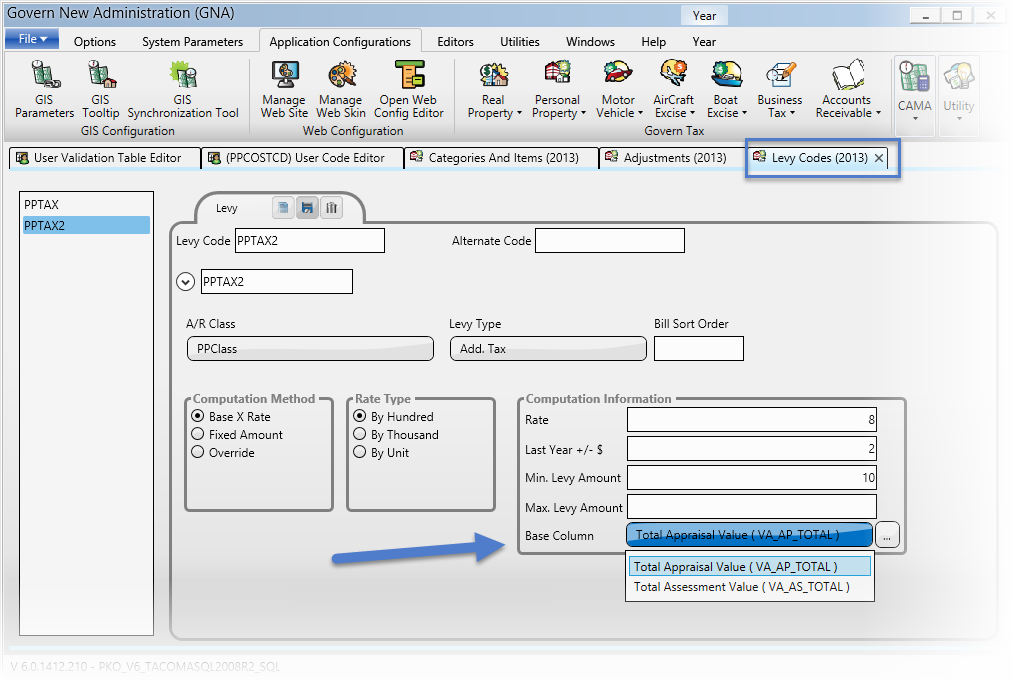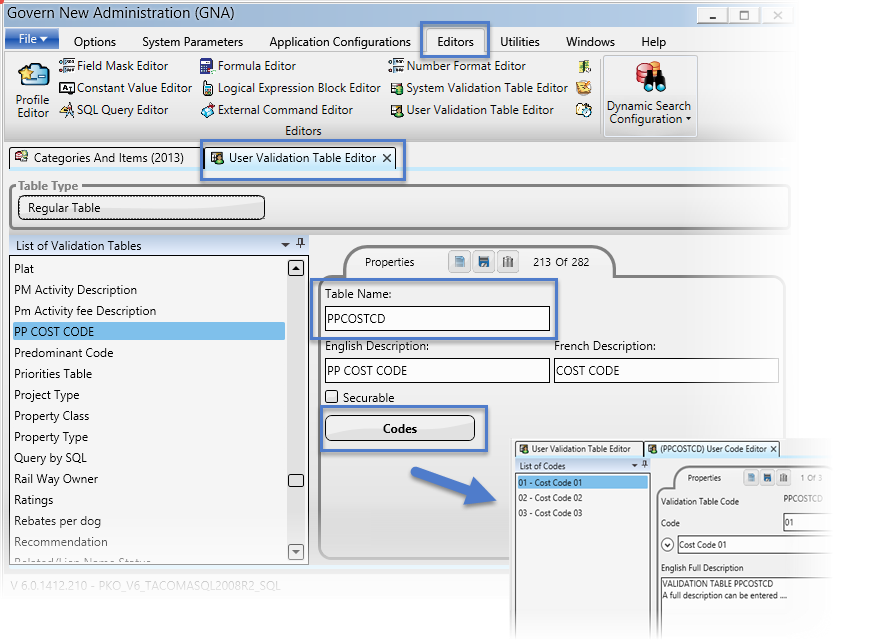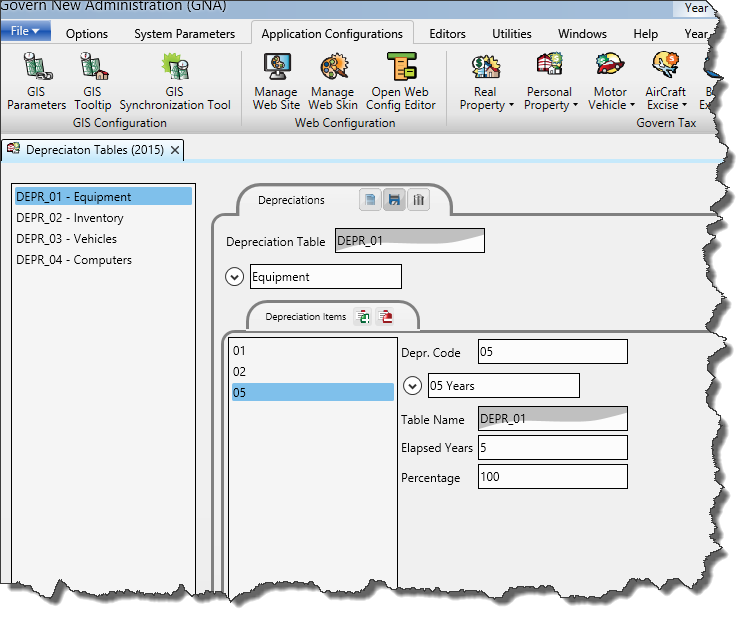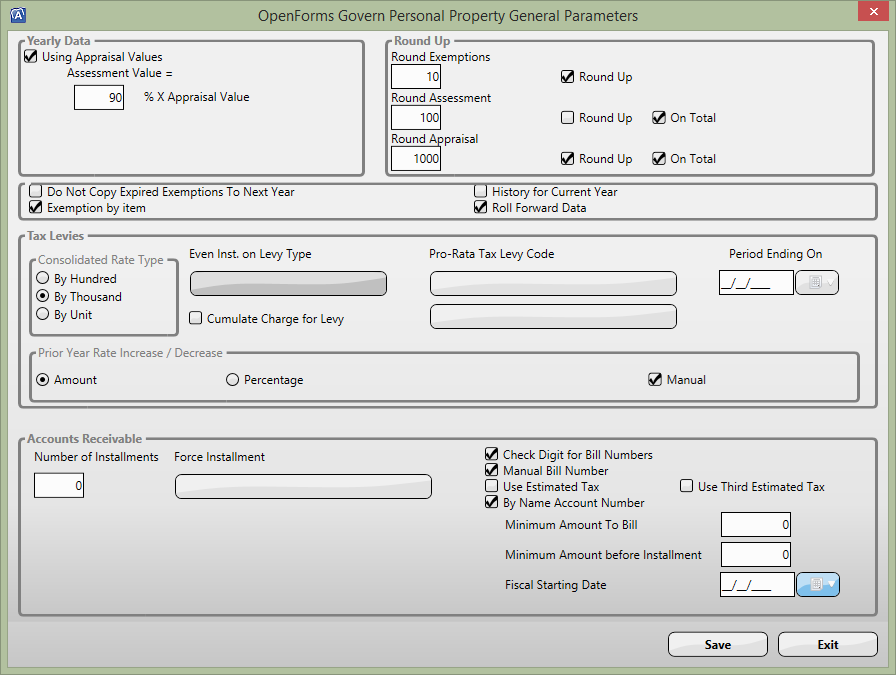Table of Contents
Overview
Reviewing Records
Self Reported Tax Categories command buttons
Self Reported Tax Categories tabs
General tab
Fields tab
Levies tab
Exemptions tab
Multimedia Codes tab
Setting up Self Reported Tax Categories
Self Reported Tax Category – General tab
Penalties and Interest tab
Discount tab
Penalties and Interest tab
Structure of ST_PARM_CATEG Table
Self-Reported Tax Exemptions by Categories
Late Payment Monthly Penalty Option
Table Modifications:
Structure of ST_PARM_CATEG Table
Self-Reported Tax Exemptions by Categories
Late Payment Monthly Penalty Option
Table Modifications:
Structure of ST_PARM_CATEG Table
Related Topics
Use the Self-Reported Tax Categories form to create categories for self reported tax. You can add penalties and discounts to the categories. Then, set up Fields and Levies for each category.
To access the Self Reported Tax Category form:
1. Launch the Govern New Administration (GNA).
2. Under the Application Configurations menu, select Business Tax > Categories…
Reviewing Records
Existing or newly created records are viewed on the left hand side in a list. Click to select a records, its properties will be displayed in the forms.
Self Reported Tax Categories command buttons
Create a New Item: Click to create a new Self Reported Tax (ST) category.
Cancel Changes: After creating a new category or when making changes to an existing one, the Create a ne w item button will change to the Cancel
Changes icon. Click to cancel changes to a newly created or existing category.
Save the Current Item: Click to save a category or changes.
Delete: Select and click Delete to remove a category.
Self Reported Tax Categories tabs
General tab
The General tab contains the parameters required to configure Penalties and Interest, and Discounts. See Self Reported Tax Category – General tabSelf Reported Tax Category – General tab.
Fields tab
Use the Self Reported Tax Fields form to create data entry fields and computed fields that follow custom computation rules on the Self Reported Tax function. See Modify fields of Self Reported Tax Categories Form.
Levies tab
Click the Levies tab to create tax levies for Business Tax. You can define a levy type and computation method for each levy. See Levies and Exemptions tabs.
Exemptions tab
To add exemptions by categories, click the Exemptions tab. See Levies and Exemptions tabs.
Exit: Click Exit to close the form; you will be prompted if there are unsaved changes.
Multimedia Codes tab
The Multimedia Codes tab is used to specify the Multimedia file types accepted by the system, and if a submission is mandatory (Is Required) with the record.
NOTE: The Multimedia file types that are supported by the system will vary depending upon administration setup.
Setting up Self Reported Tax Categories
To set up Self Reported Tax categories:
1. In the Categories form, click Create a New Item to clear the form.
2. Enter a Category Code.
3. Enter a Short Description and Long Description. This information is saved to VT_USR_ST_CATEG.
4. Select a Department.
NOTE: Self Reported Tax information is saved by Department.
5. When the category is not to be made available on the Web for the eGov Web Portal, click to select the Hide on Web option.
Self Reported Tax Category – General tab
Penalties and Interest tab
6. Under the Penalties and Interest tab, Enter penalties and interest charges, as percentages, and select AR Class Codes for each of the following:
7. Enter penalties and interest charges, as percentages, and select AR Class Codes for each of the following:
- Late Filing
- Minimum Late Filing
- Late Payment
- Incorrect Filing
- Incorrect Payment
- Negligence Penalty
- Penalty for a Not Sufficient Funds (NSF) check.
- Monthly Interest
8. Select an A/R class for adjustments.
9. Enter an amount in the Minimum Late Filing text box, if applicable.
Discount tab
To create a discount, you will need to do one of the following:
- Create a fixed amount, by selecting Fixed Percentage. Enter the fixed percentage value.
OR
- Set up different percentages, by not selecting Fixed Percentage. Enter a percentage of a first amount, enter the amount. Now enter a percentage for the remaining amount.
10. Enter a maximum amount, in dollars, for the discount if applicable.
11. Click Save the current item on the Category tab.
12. Repeat this procedure for each category created.
Penalties and Interest tab
Monthly Late Payment Penalty group: You are able to specify a monthly penalty as an option when you are creating Business Tax categories. Three (3) fields are available in the ST_PARM_CATEG table.
Structure of ST_PARM_CATEG Table
The following is the structure of the ST_PARM_CATEG table.
| Field Name |
Data Type |
Description |
| PEN_METHOD |
Number |
Value = -1 if Monthly late payment penalty applies; Value = 1 otherwise |
| PEN_MAX_PCT |
Number |
Maximum Late Payment PenaltyPercentage. |
| PEN_MAX_MONTH |
Number |
Maximum Number of Months of Late Payment Penalty. |
Click to display the option in this group. They allow you to enable the Monthly Late Payment option; when selected, you may specify the Maximum number of months that the Penalty is applied.
1. In the Business Tax Categories form, click New to clear the form.
2. Select a department.
3. Enter a Category Code, Short Description and Long Description. This information is saved to VT_USR_ST_CATEG.
4. Enter penalties and interest charges, as percentages, and select AR Class Codes for each of the following:
- Late Filing
- Late Payment
- Incorrect Filing
- Incorrect Payment
- Negligence Penalty
- Penalty for a Not Sufficient Funds (NSF) check.
- Monthly Interest
5. Select an A/R class for adjustments.
NOTE: The value that is entered in the Maximum Interest and Penalty value will be overridden by the value entered in the Minimum Late Filing parameter in the Self Reported Tax Categories form; In the Govern New Administration (GNA): Application Configurations > Business Tax > Categories.
For Example: If you owe $100.00, and a maximum interest and penalty charge is set to 25%, your penalty amount would be $25.00 Should the Minimum Late Filing charge be set to $50.00 in the Self Reported Tax Categories form, regardless of the calculation percentage, you will be charged $50.00.
Self-Reported Tax Exemptions by Categories
Occasionally, it may be necessary to apply exemptions to Self-Reported Tax (ST) records. The Exemptions tab of the Self Reported Tax Categories form allows you to configure exemptions to each of your SRT categories. In addition preferences can be set for when the calculation will apply, before or after the tax calculations.
You should first set up the A/R Classes for the Self-Reported Tax Categories in the Govern New Administration (GNA). For steps to create SRT classes, see Accounts Receivable Classes.
To set up exemptions in the Govern New Administration (GNA):
1. Select Applications Configurations (tab) > Business Tax > Categories.
2. In the Self-Reported Tax Categories form, create a new category or select an existing category.
3. Complete the form; enter the applicable percentages and select A/R Classes in the Penalties and Interest group.
4. If applicable, enter a Minimum Late Filing charge.
NOTE: The value that is entered in the Minimum Late Filing Charge parameter overrides any settings that may have been configured in the individual ST A/R Classes.
5. Click the Exemptions tab to configure exemptions.
6. Complete the parameters of the Category Exemptions form.
Exemptions can be applied by amount or by percentage. The exemption can also be applicable before or after the tax calculation.
7. Select whether the exemption will be by amount or percentage in the Exemption By group.
8. Select the point at which the exemption is applicable, before or after the tax calculation; make your selection in the Exemption Applicable group.
9. Click Save to complete your setup and return to the Business Tax Categories form.
Late Payment Monthly Penalty Option
You are able to specify a monthly penalty as an option when you are creating your Self-Reported Tax categories. As a result of this feature, three (3) fields have been created in the ST_PARM_CATEG table. This option is enabled in the Govern New Administration (GNA).
To enter a Monthly Penalty for an SRT category in GNA.
1. Select Applications Configurations (tab) > Business Tax > Categories.
2. In the Penalties and Interest tab, click to select the Monthly Late Payment Penalty option.
3. Enter parameters for a Maximum number of months of late payment penalties.
Table Modifications:
The following modifications have been made to the ST_PARM_CATEG table.
Structure of ST_PARM_CATEG Table
The following is the structure of the ST_PARM_CATEG table.
| Field Name |
Data Type |
Description |
| PEN_METHOD |
Number |
Value = -1 if Monthly late payment penalty applies; Value = 1 otherwise |
| PEN_MAX_PCT |
Number |
Maximum Late Payment Penalty
Percentage. |
| PEN_MAX_MONTH |
Number |
Maximum Number of Months of Late Payment Penalty. |
Click to display the option in this group. They allow you to enable the Monthly Late Payment option; when selected, you may specify the Maximum number of months that the Penalty is applied.
1. In the Business Tax Categories form, click New to clear the form.
2. Select a department.
3. Enter a Category Code, Short Description and Long Description. This information is saved to VT_USR_ST_CATEG.
4. Enter penalties and interest charges, as percentages, and select AR Class Codes for each of the following:
- Late Filing
- Late Payment
- Incorrect Filing
- Incorrect Payment
- Negligence Penalty
- Penalty for a Not Sufficient Funds (NSF) check.
- Monthly Interest
5. Select an A/R class for adjustments.
NOTE: The value that is entered in the Maximum Interest and Penalty value will be overridden by the value entered in the Minimum Late Filing parameter in the Self Reported Tax Categories form; In the Govern New Administration (GNA): Application Configurations > Business Tax > Categories.
For Example: If you owe $100.00, and a maximum interest and penalty charge is set to 25%, your penalty amount would be $25.00. Should the Minimum Late Filing charge be set to $50.00 in the Self Reported Tax Categories form, regardless of the calculation percentage, you will be charged $50.00.
Self-Reported Tax Exemptions by Categories
Occasionally, it may be necessary to apply exemptions to Self-Reported Tax (ST) records. The Exemptions tab of the Self Reported Tax Categories form allows you to configure exemptions to each of your SRT categories. In addition preferences can be set for when the calculation will apply, before or after the tax calculations.
You should first set up the A/R Classes for the Self-Reported Tax Categories
in the Govern New Administration (GNA). For steps to create SRT classes, see Accounts Receivable Classes XXXXX.
To set up exemptions in the Govern New Administration (GNA):
1. Select Applications Configurations (tab) > Business Tax > Categories.
2. In the Self-Reported Tax Categories form, create a new category or select an existing category.
3. Complete the form; enter the applicable percentages and select A/R Classes in the Penalties and Interest group.
4. If applicable, enter a Minimum Late Filing charge.
NOTE: The value that is entered in the Minimum Late Filing Charge parameter overrides any settings that may have been configured in the individual ST A/R Classes.
5. Click the Exemptions tab to configure exemptions.
6. Complete the parameters of the Category Exemptions form.
Exemptions can be applied by amount or by percentage. The exemption can also be applicable before or after the tax calculation.
7. Select whether the exemption will be by amount or percentage in the Exemption By group.
8. Select the point at which the exemption is applicable, before or after the tax calculation; make your selection in the Exemption Applicable group.
9. Click Save to complete your setup and return to the Business Tax Categories form.
Late Payment Monthly Penalty Option
You are able to specify a monthly penalty as an option when you are creating your Self-Reported Tax categories. As a result of this feature, three (3) fields have been created in the ST_PARM_CATEG table. This option is enabled in the Govern New Administration (GNA).
To enter a Monthly Penalty for an SRT category in GNA.
1. Select Applications Configurations (tab) > Business Tax > Categories.
2. In the Penalties and Interest tab, click to select the Monthly Late Payment Penalty option.
3. Enter parameters for a Maximum number of months of late payment penalties.
Table Modifications:
The following modifications have been made to the ST_PARM_CATEG table.
Structure of ST_PARM_CATEG Table
The following is the structure of the ST_PARM_CATEG table.
| Field Name |
Data Type |
Description |
| PEN_METHOD |
Number |
Value = -1 if Monthly late payment penaltyapplies; Value = 1 otherwise |
| PEN_MAX_PCT |
Number |
Maximum Late Payment PenaltyPercentage. |
| PEN_MAX_MONTH |
Number |
Maximum Number of Months of LatePayment Penalty. |
Related Topics
Calculating Self Reported Tax Late Filing and Late Payment Charges
Self Reported Business Tax – What’s New
Self-Reported Business Tax Module Overview





